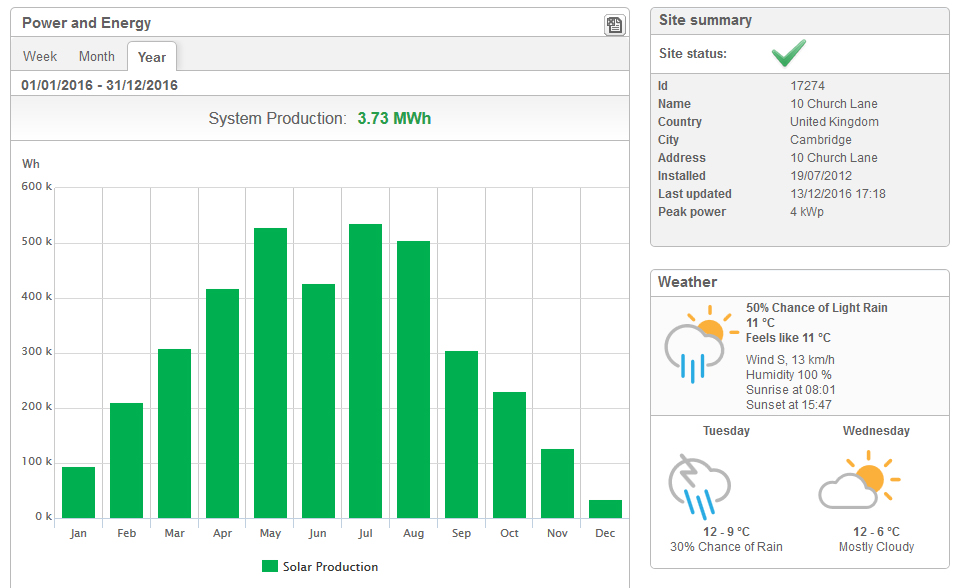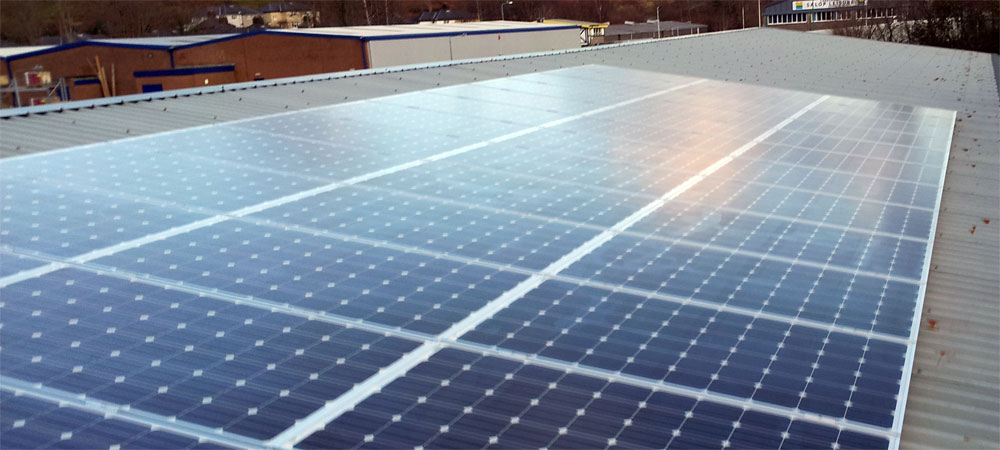Solar Panel Monitoring | Solar Energy Monitors
Solar panel monitoring and solar energy monitors
 Solar panel monitoring is important. It is vital that solar panels are monitored regularly in one way or another. You need to make sure they are operating correctly and the system is generating as much as predicted. If you have solar panels installed, you should at the very least check the generation meter once a week and take a note of the reading. This article will introduce solar panel monitoring systems, give a couple of cautionary stories about monitoring, go through the benefits of monitoring and then go through the different types of solar monitoring system in a bit more detail. We also provide instructions on how to monitor your solar panel system, how to track your actual production against the estimated yield and there are a couple of downloads that will help.
Solar panel monitoring is important. It is vital that solar panels are monitored regularly in one way or another. You need to make sure they are operating correctly and the system is generating as much as predicted. If you have solar panels installed, you should at the very least check the generation meter once a week and take a note of the reading. This article will introduce solar panel monitoring systems, give a couple of cautionary stories about monitoring, go through the benefits of monitoring and then go through the different types of solar monitoring system in a bit more detail. We also provide instructions on how to monitor your solar panel system, how to track your actual production against the estimated yield and there are a couple of downloads that will help.
Introduction to Solar panel monitoring
Two quick cautionary tales
Benefits of solar panel monitoring
Types of solar energy monitors
Introduction to Solar panel monitoring
There are many potential ways of monitoring solar panels. There are high tech solutions which upload data continuously to a web portal which allows you to monitor your systems performance from anywhere in the world and there are simple methods like manually noting down the reading on your generation meter once a week in a log book.
Broadly speaking you can classify the monitoring of solar panel systems into the following groups:
-
Internet monitoring systems
-
Home energy monitoring systems
-
Manual recording
Internet and Home energy monitoring can also be split into three groups:
-
Inverter monitoring systems
-
Generation meter monitoring system
-
Retro fit systems
And just to keep things simple (!) there are two type of sub-category:
-
Generation only monitors - just measuring the electrical energy output from the solar panels
-
Generation and consumption monitors - measuring electrical energy output from the solar panels and energy consumption of the property
-
Consumption only monitors - measuring the electrical energy consumption of the property in questions
Sometimes more than one method is used – in fact, even with the simplest of systems you will at the very least have a reading from your generation meter and your inverter. We go into all of the above systems later on in the article. Click on the link if you want to jump straight there.
Note: Please bear in mind that the official reading that you need to provide your electricity supplier with is always your Generation Meter reading. Your generation meter will look something like these and will normally be installed next to your consumer unit (fuse board) or sometimes next to the inverter.
If you are unfamiliar with the layout of a solar panel system please take a look at our article explaining the different components and layout of a solar pv system: Solar Panel System Layout
Two quick cautionary tales
Tale 1
A few years ago, in the late summer, I visited a lady who had had a solar panel system installed by another installer a few years earlier. The installer had gone out of business and she was looking for a reliable local installer to help her. She had tried to give a feed-in tariff reading to her electricity supplier and they had told her that the reading was exactly the same as the previous quarter. The solar panel systems switch had been tripped in the consumer unit and the system had been off for over 3 months. She had missed out on three of the most productive months of the year where she would have lost out on £100’s in savings and feed-in tariff payments. We repaired the system and supplied an attractive table-top energy monitor that was put on the kitchen counter so that she could easily keep an eye on the systems performance day to day.
Tale 2
A couple of winters ago I got a call from a gentleman who had just completed his first year of solar generation. The panels had not generated anything like the ammount of energy he was expecting them to - again, sadly, the solar comany that had carried out the installation was no longer around to help. On close inspection of the inverter it became apparent that half of the solar panels had not been plugged into the inverter correctly(!). Again, if the end user had some easy way of monitoring solar production and had some rough idea of likely generation this problem could have been solved much earlier.
Benefits of monitoring your solar panel system
You can always check the inverter or generation meter so why install a monitoring system? Well if your inverter, or more likely, your generation meter is easy to access then great, but you do need to make sure you get into the habit of checking this regularly and noting down the readings.
With modern live-feed monitoring systems you know that you can see accurately what's going on on your system. Benefits include:
-
You know your solar panel system is operating correctly.
-
You know that your system is on target to reach its annual yield target.
-
You can track your return on investment and payback periods.
-
You can analyse the data and compare previous days, month and years.
-
You know how much energy you are generating so you know it is a good time to switch on a washing machine or dishwasher – or switch something off.
-
You know whether or not it is worth investing in a solar immersion controller or a solar battery system because you know how much energy you are exporting to the grid.
-
With an internet enabled system your installer or manufacturer can view the systems performance remotely and carry out remote diagnosis and troubleshooting if there are any issues with the system.
Types of solar panel monitoring system
Online monitoring systems - Most modern inverters now come either wifi enabled or with wifi or network kits so that the inverters can be connected to the internet.
There are also systems that are inverter independent that integrate with your generation meter and upload the performance data to a web portal. These are great if your inverter choice does not have the ability to connect to a network. These are normally used for new installations as they are designed to operate with a specific generation meter and although generation meters can be changed it does require some paperwork and a bit of faff. These are very good because they are very accurate, have the same official readings as the generation meter and they don’t require current clamps – however they do need to be installed by a qualified installer.
There are also retro-fit systems – these are normally current clamp systems where clamps sit around the incoming supply into the property and the output from the solar pv system. These are great if you already have an existing solar pv system that may be a few years old. However they can be a bit fiddley and current clamps have to put on in exactly the right location and the right way around in order to work properly.
All of the three above types, the inverter web monitoring the generation meter web monitoring and the retro-fit web monitoring can be found in two categories: systems that monitor generation only and systems that monitor generation and consumption.
Useful solar panel monitoring links
Below are a some useful links relating to the monitoring of solar panel systems. Each of the manufacturer show public and example sites so you can test out their monitoring portals.
- Solar Edge's monitoring site - https://monitoring.solaredge.com/
- SMA's monitoring site - https://www.sunnyportal.com/
- Enphase's solar monitoring site - https://enlighten.enphaseenergy.com/

